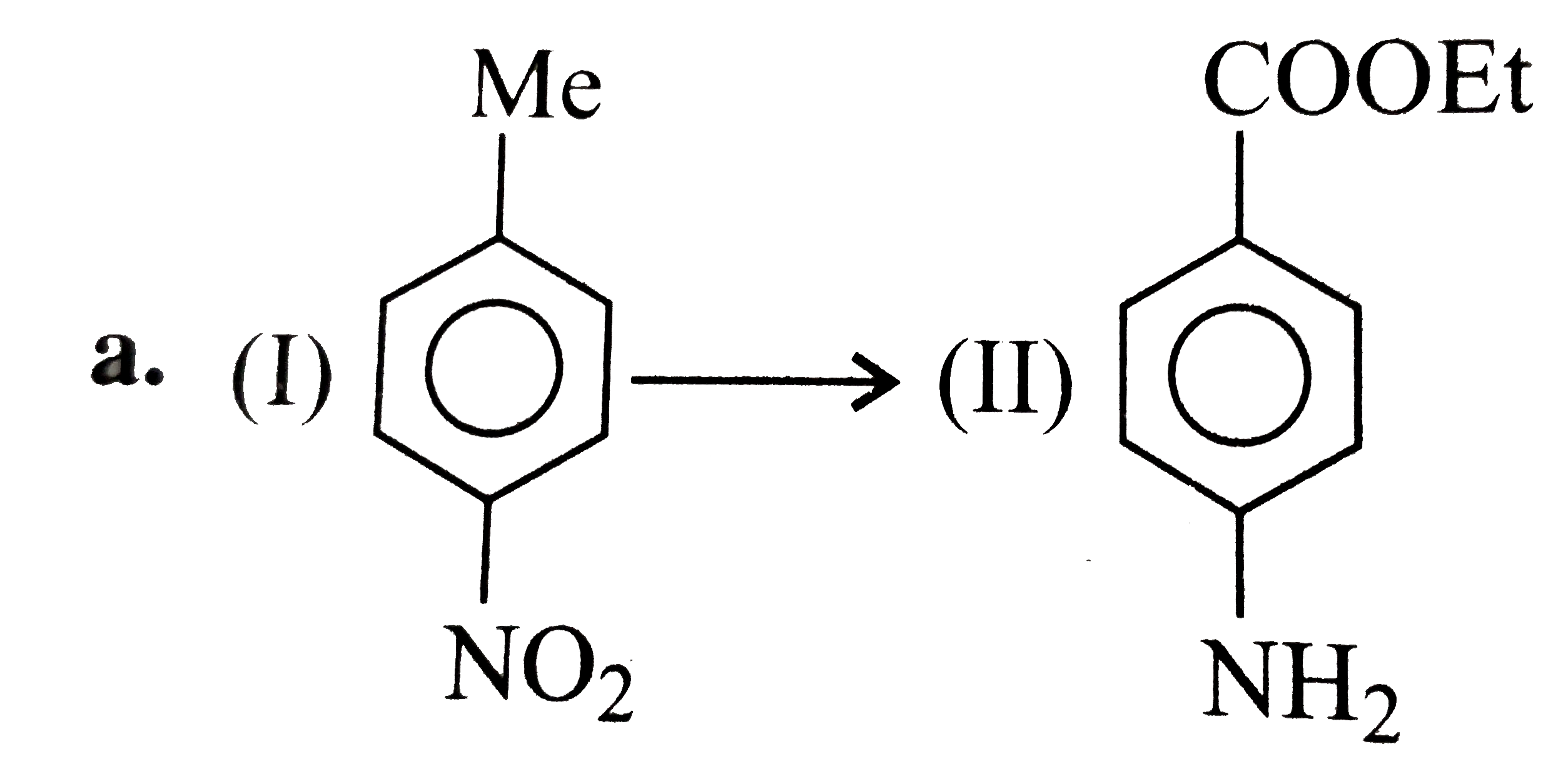Convert the following:
Chloroethane to methanamine.
To convert chloroethane (C2H5Cl) to methanamine (CH3NH2), we can follow these steps:
Step 1: React Chloroethane with Ammonia
- Reaction: C2H5Cl + NH3 → C2H5NH2 + HCl
- Explanation: Chloroethane reacts with ammonia to form ethylamine (C2H5NH2) and hydrochloric acid (HCl).
Step 2: Convert Ethylamine to Ethylammonium Chloride
- Reaction: C2H5NH2 + HCl → C2H5NH3Cl
- Explanation: Ethylamine can react with hydrochloric acid to form ethylammonium chloride.
Step 3: React with Sodium Nitrite (NaNO2) and Hydrochloric Acid (HCl)
- Reaction: C2H5NH3Cl + NaNO2 + HCl → C2H5N2Cl + 2H2O
- Explanation: The ethylammonium chloride reacts with sodium nitrite in the presence of hydrochloric acid to form ethyl diazonium chloride (C2H5N2Cl).
Step 4: Hydrolyze Ethyl Diazonium Chloride
- Reaction: C2H5N2Cl + H2O → C2H5OH + N2 + HCl
- Explanation: Hydrolysis of ethyl diazonium chloride yields ethanol (C2H5OH), nitrogen gas (N2), and hydrochloric acid.
Step 5: Oxidation of Ethanol to Acetic Acid
- Reaction: C2H5OH + (O) (from KMnO4) → CH3COOH
- Explanation: Ethanol is oxidized to acetic acid (CH3COOH) using an oxidizing agent like potassium permanganate (KMnO4).
Step 6: Convert Acetic Acid to Acetamide
- Reaction: CH3COOH + NH3 → CH3CONH2 + H2O
- Explanation: Acetic acid reacts with excess ammonia to form acetamide (CH3CONH2).
Step 7: Perform Hofmann Degradation
- Reaction: CH3CONH2 + Br2 + NaOH → CH3NH2 + NaBr + Na2CO3 + H2O
- Explanation: Acetamide undergoes Hofmann degradation to yield methanamine (CH3NH2).
Final Product
- The final product is methanamine (CH3NH2).
Summary of Steps
1. Chloroethane + NH3 → Ethylamine + HCl
2. Ethylamine + HCl → Ethylammonium Chloride
3. Ethylammonium Chloride + NaNO2 + HCl → Ethyl Diazonium Chloride
4. Ethyl Diazonium Chloride + H2O → Ethanol + N2 + HCl
5. Ethanol + (O) → Acetic Acid
6. Acetic Acid + NH3 → Acetamide
7. Acetamide + Br2 + NaOH → Methanamine
- Reaction: C2H5Cl + NH3 → C2H5NH2 + HCl
- Explanation: Chloroethane reacts with ammonia to form ethylamine (C2H5NH2) and hydrochloric acid (HCl).
- Reaction: C2H5NH2 + HCl → C2H5NH3Cl
- Explanation: Ethylamine can react with hydrochloric acid to form ethylammonium chloride.
- Reaction: C2H5NH3Cl + NaNO2 + HCl → C2H5N2Cl + 2H2O
- Explanation: The ethylammonium chloride reacts with sodium nitrite in the presence of hydrochloric acid to form ethyl diazonium chloride (C2H5N2Cl).
- Reaction: C2H5N2Cl + H2O → C2H5OH + N2 + HCl
- Explanation: Hydrolysis of ethyl diazonium chloride yields ethanol (C2H5OH), nitrogen gas (N2), and hydrochloric acid.
- Reaction: C2H5OH + (O) (from KMnO4) → CH3COOH
- Explanation: Ethanol is oxidized to acetic acid (CH3COOH) using an oxidizing agent like potassium permanganate (KMnO4).
- Reaction: CH3COOH + NH3 → CH3CONH2 + H2O
- Explanation: Acetic acid reacts with excess ammonia to form acetamide (CH3CONH2).
- Reaction: CH3CONH2 + Br2 + NaOH → CH3NH2 + NaBr + Na2CO3 + H2O
- Explanation: Acetamide undergoes Hofmann degradation to yield methanamine (CH3NH2).
- The final product is methanamine (CH3NH2).
1. Chloroethane + NH3 → Ethylamine + HCl
2. Ethylamine + HCl → Ethylammonium Chloride
3. Ethylammonium Chloride + NaNO2 + HCl → Ethyl Diazonium Chloride
4. Ethyl Diazonium Chloride + H2O → Ethanol + N2 + HCl
5. Ethanol + (O) → Acetic Acid
6. Acetic Acid + NH3 → Acetamide
7. Acetamide + Br2 + NaOH → Methanamine
Topper's Solved these Questions
- SAMPLE PAPER 2022 TERM IIBOOK - CBSE MODEL PAPERCHAPTER - SAMPLE PAPER 2022 TERM IIEXERCISE - SECTION-C
5 Videos
- SAMPLE PAPER 2022 TERM IIBOOK - CBSE MODEL PAPERCHAPTER - SAMPLE PAPER 2022 TERM IIEXERCISE - SECTION-C
5 Videos
- SAMPLE PAPER 2022BOOK - CBSE MODEL PAPERCHAPTER - SAMPLE PAPER 2022EXERCISE - SECTION C
6 Videos
- SAMPLE PAPER 2023 TERM IBOOK - CBSE MODEL PAPERCHAPTER - SAMPLE PAPER 2023 TERM IEXERCISE - SECTION E
7 Videos
Similar Questions
Convert of following :

View SolutionConvert the following:
a.
b.
View SolutionConvert the following :
(a)
View SolutionHow will you convert the following:
Ethanoic acid into methanamine
View SolutionHow will you canvert the following :
(i) Nitrobenzene into aniline,
(ii) Ethanoic acid into methanmine
(iii) Aniline into N-phenylethanaminde (write the chemical equations involved).
View Solutiona.Convert the following
a.
b. .
.
View SolutionHow will you convert the following :
(i) Nitrobenzene into aniline
(ii) Ethanoic acid into methanamine
(iii) Aniline into N-phenylethanamide.
Write the chemical equations involved.
View SolutionConvert the following into decimal
9%
View SolutionConvert the following into decimal
1%
View SolutionConvert the following into decimal
25%
View Solution
